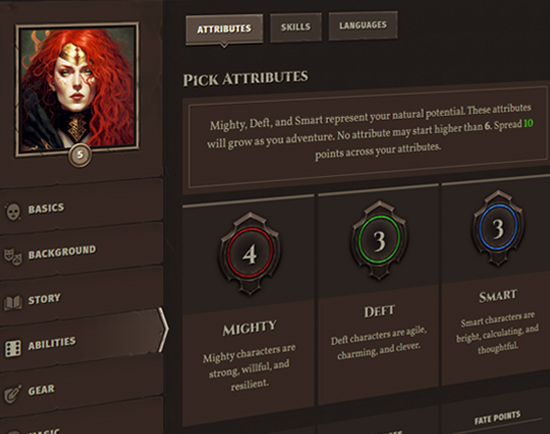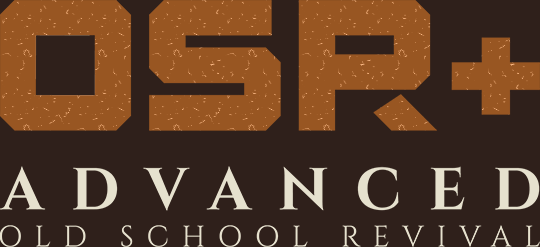Rolling for a Scene
Sometimes the GM may want to resolve an entire scene without resorting to turn-by-turn action. A scene check is made up of one or three rolls, each roll representing an "act" within the scene. Each roll functions like a success check, but the target number (TN) for a clean success escalates with each act.
The GM starts by establishing the stakes in each act. The stakes represent what is to be gained by a clean success, but the GM doesn't reveal the consequences of rolling at a cost or rolling poorly.
Scene Check Procedure
A scene check happens in abstract time, meaning you may be doing things as a party for an indeterminate amount of time, as determined by the GM. For example, you might be trying to sneak into the Emperor's inner sanctum to poison his favorite goblet, which may require you to infiltrate the Emperor's palace in act I, find a way to unlock his heavily fortified sanctum in act II, and then deliver the poison into the goblet without his elite guard noticing in act III. This could take rounds, hours, or even days, depending on the approach the party designs.
- The GM presents what's at stake in the scene (e.g., the party must infiltrate the Emperor's palace).
- The party discusses their approach to infiltrating the palace and how each character might be able to contribute to the plan.
- The GM makes a ruling as to which attribute best describes their approach and establishes the starting TN, and then optionally offers a raise. If they planned to barge in and cause a commotion, the GM might rule that the plan is Mighty. If they plan to sneak in through the servants quarters, the approach might be Deft, and so on.
- The party then decides who's adopting each role in the scene (see below) to structure the roll itself. They may also make wager to the GM at this point.
- The die is cast and the GM describes the outcome of the scene.
Roles in a Scene Check
There are always at least three roles in a scene check to fill: the Point Person, the Heavy Lifter, and the Supporter.
- The Point Person is the hero organizing the plan and keeping everyone on their toes as it executes. This hero rolls the d6 and is considered to be leading the action.
- The Heavy Lifter provides support that is essential to the plan, and usually its execution hinges on their involvement. This hero adds their attribute to the roll that matches the nature of the action (as determined by the GM in step 3). If the hero's attribute is reduced in any way (such as from attribute damage) or the hero has wounds, factor in these penalties into the total attribute score.
- Finally, up to two Supporters contribute peripheral talent to the plan, to round out contingencies or strengthen its execution. These heroes may add a story tag, skill, or stance to the roll. On top of this, the GM may also apply a weakness tag from any of the heroes involved against the roll or from any global story tags at his disposal.
If there are fewer characters than three to participate, a single character may make the roll and apply the attribute. If there are more than four heroes involved, the extra heroes can still collaborate, and their participation allows for more options within each part of the roll: alternative story tags, skills, stances, or a choice between attributes.
Scene Check Target Number Table
| target | act 1 | act 2 | act 3 |
|---|---|---|---|
| Poor | 6 or less | 7+ | 11+ |
| Average | 7+ | 11+ | 13+ |
| Good | 11+ | 13+ | 15+ |
| Exceptional | 13+ | 15+ | 17+ |
| Extraordinary | 17+ | 21+ | 25+ |
| Legendary | 21+ | 25+ | 29+ |
Acting in the Scene
What exactly does it mean for heroes to contribute to a scene check?
Whatever a hero does fictionally justifies what she contributes to the roll mechanically. She might be casting spells, fighting off hordes, rigging up traps, or gabbing with courtiers—likely she’s doing all these things throughout the duration of the scene.
For this reason, spells or other abilities the heroes might be using as part of their action can't be used to enhance the roll itself. For example, you can't confer advantage on the roll with a spell or alter its TN with a stance. The roll is the collaborative outcome of everyone who contributes to the scene.
Raises & Wagers
The GM may offer a raise in acts 2 and 3, after he rules the attribute.
A raise represents new developments in the scene the party can take advantage of, if they accept the added risk.
For example, if the party is breaking into a prison to save someone, they may learn in act 2 that the person they're rescuing has a jailmate who also needs rescuing. As another example, a party engaged in an epic battle against a foe may notice that the foe's throne sits upon an explosive lodestone that if disrupted, could turn the tide of battle.
In both scenarios, it will take extra effort for the party to take advantage of the raise. If the party accepts the raise, the GM confers a -2 penalty to the roll in that act.
Typically the raise offers something narratively advantageous to the party, not mechanical. The party itself may also create a raise, but in this case it is called a wager. The GM may reject (or alter and accept) a wager, in the same way the party may accept a raise.
Single-Act Scene Check
If the GM calls for a single-act scene check, then the scene check is complete in one roll. In this case, you may only have one Supporter role in the check. (The GM may also offer a raise and the party may also offer a wager in this act.)
Stances & Scene Checks
Some stances can be used in the context of a scene check; a stance will say explicitly if this is the case and how it affects the check. Otherwise, a stance can be used like a skill or a story tag as the Supporter role if its flavor text and your application of it in the scene meets the description of the action you're taking (with GM discretion). In this case, the stance adds a +2 to the roll like skills or story tags, but it is not considered "used" in the same way you do not spend MP for casting spells abstractly in the context of a scene check.
Time in a scene check is abstract, meaning the GM may skip vast gulfs of time between acts in the scene check. If you use a stance in a scene check, your stance doesn't reset until after you've had a chance to rest in another game mode.
Deed Dice & Scene Checks
Deed dice cannot be used in scene checks.
 Archetypes
Archetypes Armor
Armor Classes
Classes Conflicts
Conflicts Cultures
Cultures Ethos
Ethos Flaws
Flaws Glossary
Glossary Kits
Kits Maleficence
Maleficence Origins
Origins Shields
Shields Skills
Skills Spells
Spells Stances
Stances Status Effects
Status Effects Tactics
Tactics Talents
Talents Techniques
Techniques Treasure
Treasure Weapons
Weapons











 Hall of Heroes
Hall of Heroes Hall of Legends
Hall of Legends



 Dungeons & Flagons
Dungeons & Flagons